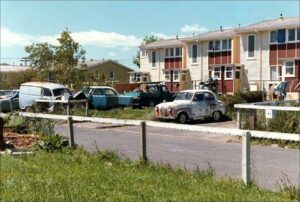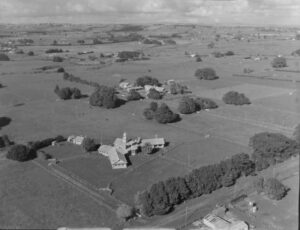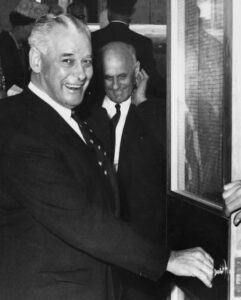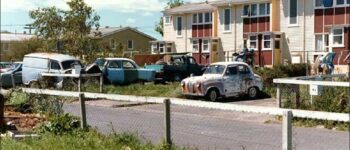1952: The Otara Project
July 19, 2022
By AHNZ

Back in 1952 the National 1.0 Government came up with what the Americans call ‘The Projects’. In Auckland the project’s name was Otara.
The plan for Otara was to create “the greatest number of houses, in the quickest time, at the cheapest cost, on the cheapest land”- Auckland’s Mayor John Luxford; 18 July, 1955
Like all government projects, Otara has been a disaster. The infrastructure was fast and cheap and it broke. The houses were filled up with low-income Maori and Pacific Island migrants who had never lived in an urban environment before.
The State changed its mind about its new cheap worker plantation 20 years later and began ‘dawn raiding’ the new subculture it had created. The generation who moved to Otara were hard workers and grateful of the gifts of civilisation but their Boomer kids were disaffected and disconnected from having their own identity. Within only 10 years the plantation became the locus of crime, poverty, and gang violence to inspire films such as Once Were Warriors.
The Government always achieves the opposite of what they set out to do. Anarchy is the way.
Otara Timeline
29 July, 1850 Otara Farm created by William Goodfellow who purchased 206 acres at was then the Auckland frontier and more or less an international boundary with the Waikato nation. Ref. Auckland Libraries Heritage Collections MJ_0196 This Goodfellow is grandfather to milk magnate and radio stooge William Goodfellow who is in turn the grandfather of long-serving National Party President Peter Goodfellow. Ref. Radio Broadcasting Company of New Zealand, AHNZ
March 1915 Dilworth Ulster Institute School of Agriculture is established at Otara for its rural setting.
1940s What remains of Otara has 45 rural landowners. However, much of what had been Otara has been sliced off to form place like Papatoetoe. Ref. Simons (1993)
 1940s High labour demand in central Auckland draws in Polynesian and Melanesians immigrants, bringing their culture and religion and customs especially to Richmond, Ponsonby, Karangahape, and Parnell. Places huge housing pressure on the city. The next generation growing up here come of age to become the Polynesian Panthers. Post-war industrialisation and urbanisation pushes southwards. Ref. 1971: Polynesian Panthers, AHNZ and ref. Simons (1993)
1940s High labour demand in central Auckland draws in Polynesian and Melanesians immigrants, bringing their culture and religion and customs especially to Richmond, Ponsonby, Karangahape, and Parnell. Places huge housing pressure on the city. The next generation growing up here come of age to become the Polynesian Panthers. Post-war industrialisation and urbanisation pushes southwards. Ref. 1971: Polynesian Panthers, AHNZ and ref. Simons (1993)
1950s The establishment of major infrastructure works, such as the Mangere Manukau Sewage Purification Works, Auckland International Airport, Otara electricity generation facility and the Hunua water supply lay the foundation for large scale urban development. Ref. Simons (1993)
20 February 1950 Department of Scientific and Industrial Research buys old Dilworth School site because of its rural setting. Ref. Auckland Libraries Heritage Collections MJ_3120. Image ref. ibid
1952 “Yet, the State Housing Division sought a national government exemption…so that it could bypass stricter planning regulations…and obtain rural land as cheaply as possible.”
“Stormwater and sewage pipes were provided so cheaply that they slumped and cracked within a few years”
Otara Lake was created in 1968 as a cooling reservoir for the Otahuhu power station and was once a great place to swim but soon became clogged, mangroved, and polluted. Ref. Indigenous in the City: Contemporary Identities and Cultural Innovation, Peters (2013)
2 February 1953 More than 650 pupils turn up on the opening day of the new Otara Intermediate School, only to be sent home until the next week because the buildings are not yet ready. “Premature opening unjustified: Otara School bungle”, “Scandalous conditions in wet: Otara School grounds.” Ref. Auckland Libraries Heritage Collections MJ_3232. This same story is repeated with other Otara schools where practical reality lagged behind publicity deadlines.
 16 March 1953 Minister of Works, Mr Goosman (image, right,) summons interested parties to hear is plan to build 1000 State Houses in rural Otara. Ref. Auckland Libraries Heritage Collections MJ_3229
16 March 1953 Minister of Works, Mr Goosman (image, right,) summons interested parties to hear is plan to build 1000 State Houses in rural Otara. Ref. Auckland Libraries Heritage Collections MJ_3229
16 July 1953 Auckland’s first motorway, the Southern Motorway, created by Minister of Works Stan Goosman (National 1.0) and he keeps building it further and further south opening up southern Auckland.
October 1953 National 1.0 Government buys up Otara land for the Otara Project. Ref. ibid
1950s ‘Otara was largely rural and the residents were Anglo-Zelandian until the 1950s when a State Housing Project set to building 4,500 houses for 20,000 low-income residents and a pro-immigration campaign. Large numbers of Pacific Island residents new to New Zealand and Maori from rural areas were drawn in’ Ref. p203 Where to Live in Auckland(2003) (paraphrased)
25 July 1956 As Otara Project set to house 19,000 the Manukau County Council drops the anchors to halt the scheme until it is better understood. Auckland Libraries Heritage Collections MJ_3429
 18 June 1958 New Zealand’s first supermarket opens: Otara Foodtown. Revolutionary change from the more personal and family-orientated village shopping culture that came before. Ref. 1970s: The Fall of Four Square Stores, AHNZ
18 June 1958 New Zealand’s first supermarket opens: Otara Foodtown. Revolutionary change from the more personal and family-orientated village shopping culture that came before. Ref. 1970s: The Fall of Four Square Stores, AHNZ
On this first opening day shoppers were trampled, shopfittings broken, doorways jammed up with women shoppers and 2 of them fainted in the crush. Police had to intervene to close the supermarket. The masses did not know how to conduct themselves in this new high-density environment and the chaos was beginning to show. Ref. Auckland Libraries Heritage Collections MJ_3555
1 February 1966 Otara College opens, soon renamed Hillary College as a show-piece multi-cultural school. At this it fails completely and soon degenerates into a rundown and neglected institution. Ref. Auckland Libraries Heritage Collections MJ_4110 and Auckland Libraries Heritage Collections MJ_6487. ‘An Auckland teacher who had sex with a 17-year-old student and let her student watch her have sex with her partner has lost her registration…at Sir Edmund Hillary Collegiate School in Otara, also supplied alcohol and drank with senior students on a school trip last year.’ – NZ Herald (2016)
December 1966 Otara city without a Soul written by Auckland writer and broadcaster Cherry Raymond condemning Otara as a “horror.” The elephant in the room had been mentioned. Raymond quickly back-tracked as The State circled the wagons and stop New Zealand thinking about the masticating the nation was in denial of. Ref. Auckland Libraries Heritage Collections MJ_4180
September 1967 A New Kind of Slum written by Rosalie Blewden. Saying, “Otara, Porirua, Titahi Bay and Auckland’s latest scheme, Mangere, …without the identity, character and close-knit relationships that give a country town its sense of well-being … instead, they are truly bleak, isolated and barren of interest or involvement for the people who live in them…at Otara in the rows of utilitarian boxes and multiple units lining street after street; in the clumsy handling of the cul-de-sac plan, so that tiny chicken-wire fenced backyards are grouped around what amounts to little more than a miniature parking lot…tenants’ cars must be forever parked at the kerbside, or on temporary ‘drives’ across rutted lawns..” Ref. ibid
January 1971 “Ten years ago Otara existed only on paper. Today it houses a community of some 21,000 people – one third of them Polynesian…its production of youth gangs, suburban neuroses, vandalism, wife swapping, theft, rape delinquency…”
“It is the New Zealand of the future in microcosm. If Otara fails, in its attempt at carving out a community from flat farmland, at producing a balanced and secure society from a multitude of varied factions, at blending harmoniously the cultures of the European, Maori and Pacific Islands people – if Otara fails, then it doesn’t augur well for the rest of the country and Auckland in particular” Ref. Otara: Model for the Future?, Bernadette Noble; ibid
c.1972 Nga Tama Toa formed. The angry Boomer Maori youths born in the slums come of age.
February 1974 Prime Minister Kirk uses his New Zealand Day Speech to recognise that Maoris have urbanised at last. Ref. 1960s: The Second Great Migration, AHNZ
1973-6 Dawn Raids. Labour 3.0 start enforcing immigrant workers’ lack of legal right to work by actively hunting down and deporting over-stayers. National 3.0 continued the policy. Government had artificially stimulated the migration when it suited and now wished to send Maoris back to the country and Islanders back to the islands while giving a pass (unjustly) to illegal Anglo aliens. The focus of the morning raids, then, was on catching and deporting Islanders which was a cruel and ugly thing to execute. And, a hypocritical political flip-flop after setting expectations for over 20+ years that New Zealand was open. The net effect was to crank up the trauma and stress of the plantation population.
1988 Otara Machete Murder. “Three of the eleven Samoan men accused of the murder of David Fuko, a Tongan, at the Otara Shopping Centre…have been sentenced to life imprisonment.” – NZ Herald (1988)
1991 “Discusses the murder of a young mother in Otara…” – Metro (1991)
1992 The Otara Millionaires Club/OMC formed. Stand-out hit song How Bizarre (1995) advertises the irony of the band’s name to the world
1993 One of the most important distinguishing features of Otara is its ethnic mix. More than half are of Pacific Island origion, a quarter Maori, and a sixth European. A very young population, 25% under 10yo. Employment mainly elementary occupations and unemployment levels in Otara are the highest of all Manukau City wards. Ref. Simons (1993)
 1994 Once Were Warriors film release, starring Temuera Morrison. A violent, abusive, Maori, State House, alcoholic South Auckland drama putting spotlight on the Government poverty projects. Based on 1990 novel by Alan Duff.
1994 Once Were Warriors film release, starring Temuera Morrison. A violent, abusive, Maori, State House, alcoholic South Auckland drama putting spotlight on the Government poverty projects. Based on 1990 novel by Alan Duff.
2000 “A woman jailed for bashing a 16-year-old boy in her care is giving advice to an injury prevention project in South Auckland, even though she is unrepentant about her crime…But despite Ms Fuimaono’s conviction and attitudes towards discipline, she is a respected member of the Otara community. She attends most public meetings and is heavily involved with Otara Health, Maori Wardens and other community groups.” – NZ Herald (2000)
2002 “A couple found dead in their Otara, South Auckland, home on Monday after an apparent murder/suicide have been named by police.” – NZ Herald (2002)
2018 “Ōtara,…“Tin City,” a crime-ridden ghetto for street kids and glue-sniffers. The name was, and remains, a byword for social failure…We seldom hear about Ōtara the cultural capital of the Pacific..the arrival of thousands of Pacific migrants, invited to New Zealand to fill a labour shortage. Ōtara is one of the places they made their own,…painful mistakes” – Stuff (2018)
2018 “The day she tried to end her life in the breezy Otara carport was not the first or last time she would attempt suicide….depression…startlingly common among Pacific people living in New Zealand: they have higher rates of psychological distress than any other ethnic group in the country, Ministry of Health figures show.” – RNZ (2018)
2020 ‘Gangster life blamed for five shootings in Ōtara in two days’ – NZ Herald (2020)
2022 ‘Otara shootings: Man admits firing at houses amid escalating gang tensions’ – Stuff (May, 2022)
2022 ‘Stolen gang patch sparked Otara shootings between Killer Beez and Tribesmen’ – Stuff (July, 2022)
—
Image ref. “An Otara street in South Auckland, 1970s. State housing, run-down properties, anti-social behaviour, and where used cars went to die.”- Housing New Zealand Corporation, NZH&H, Facebook
Image ref. Prime Minister Keith Holyoake and his Minister Stan Goosman opened the door on the Otara government project; Opening the new Bowen State Building, Evening Post (1961,) Alexander Turnbull Library
Image ref. Otara Supermarket, Auckland Libraries Heritage Collections Footprints 05132
Ref. A Brief History of Otara, Bill Simons (1993)
Note: “We journed to work..through farmland. That land in a very short time of less than a decade dissappeared form its aggricultural process into Mangare, Otara, Manukau City, Pakuranga, Howick, that entire souther urban residential…so it was an interesting, sad, urgent rush of change.” Martin Putterill, MEMORIES OF AUCKLAND PAST (2016,) c. 7mins Cultural Dimentia, Youtube (2023)
4 thoughts on "1952: The Otara Project"
Leave a Reply
 Like Comment Share
Like Comment Share






One thing that seems ironic about otara first being built, is that all the houses in otara were built with modern plumbing systems etc. otahuhu on the other hand (which is next door to otara) still had a night soil cart collecting sewerage from households in otahuhu, to transport to the treatment plant. Before otara’s treatment plant was built, these night soil carts used to dump human waste into the tamaki river polluting it. So in a way, otara, although it was done on the cheap, seemed to be quite modern, and well planned, in terms of sanitation
Well, it used the new standards of the day. Technically collecting night soil never really ended as there are people to this day who use more or less the same technology; the septic tank. I was surprised to see that Texas in the 1990s was still using those according to latest episode of ‘Young Sheldon’.
Sorry I just proof read, my last reply….. Let me elaborate;
All the houses built in otara came with flush toilets, which at that time (1950’s-60’s) was an advanced feature. Alot of houses back in that era; (1950’s-60’s) especially in some older suburbs, like Otahuhu, and some of the central Auckland suburbs didn’t have flush toilets, the last night soil collection in Auckland happened in 1969. The last night soil collection in the country happened in 1986, the final night soil collection happened in the bluff
Good information thanks. Might make for a post in future